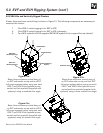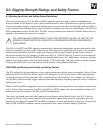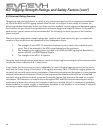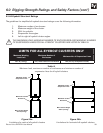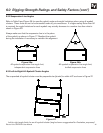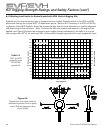
Electro-Voice EVF/EVH User Manual38
6.0 Rigging-Strength Ratings and Safety Factors (cont’)
6.2 Structural Rating Overview
Designing a safe structural cluster is usually a very complex process best left to experienced profession-
als. Since the EVH and EVF rigging options allow the user to configure a wide variety of clusters, the
following guidelines have been broken into three sections: eyebolts, vertical rigging and horizontal rigging.
Each section will give the end user guidelines for maximum weight and height of clusters. At the end of
each section, typical clusters will be recommended. The following is a short synopsis of the consider-
ations involved.
There are three independent strength ratings that, together with listed maximums, give a complete de-
scription of the overall structural capabilities of the loudspeaker cluster.
1. The strength of each M10-1.5 threaded attachment point in each of the individual enclo-
sures. This is the strength of the M10 corner bracket and the enclosure.
2. The strength of the rigging plates included in the VRK and HRK rigging kits described in
section 5.0 EVF and EVH Rigging System.
3. The strength of the M10-1.5 eyebolts.
Using the three strength ratings listed above, maximum cluster heights and weights will be recommended
so that the cluster maintains an 8:1 safety factor.
In any cluster, the forces acting on each loudspeaker (on each individual rigging point and on the enclo-
sure) and the forces acting on each point of the rigging accessory (M10-1.5 eyebolts, rigging plates and
tie plates) will vary with each cluster configuration. Determining those forces throughout a cluster requires
complex mathematical calculations. Electro-Voice engineers have therefore defined a set of simplified
structural-rating guidelines for both vertical and horizontal clusters that eliminates the need for complex
calculations. The interaction of complex forces throughout EVF and EVH clusters was analyzed using a
combination of destructive testing and computer modeling to develop this set of conservative guidelines,
presented below, to enable a rigger to immediately determine on site whether or not a cluster is safe with-
out having to make weight-distribution calculations.




